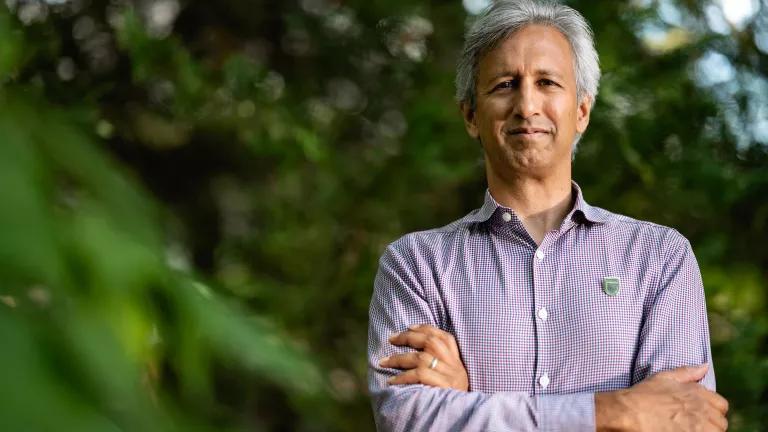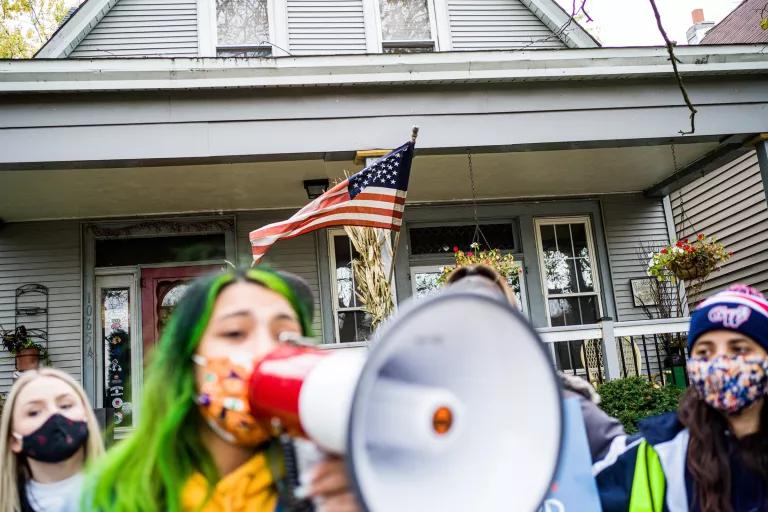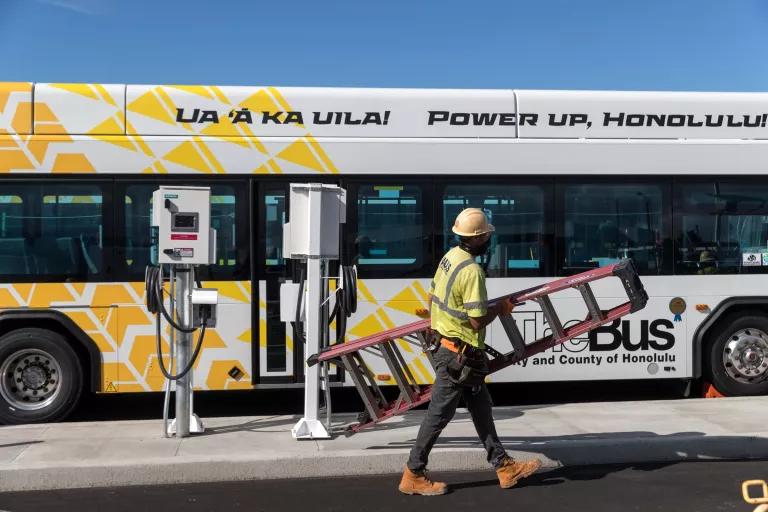A Leader to Meet This Moment
NRDC president and CEO Manish Bapna, an economist by training, knows that solving the climate emergency will require the global transformation of key economic systems—and that the transformation cannot wait a day longer.

Manish Bapna, NRDC’s new president and CEO
Manish Bapna joins NRDC as the fifth president in our 51-year history. He takes the reins at a pivotal moment. The recent Intergovernmental Panel on Climate Change (IPCC) report warned that we now have only a very narrow path to limit warming to 1.5 degrees Celsius—a threshold we nevertheless must strive to meet in order to limit the most extreme impacts of climate change. Without urgent action from international institutions, national and local governments, businesses, and civil society to rapidly reduce emissions and conserve nature, people across the planet will face even more intense hurricanes, wildfires, heat waves, and flooding than what we’re seeing now. But Bapna, an alumnus of the World Bank and the World Resources Institute (WRI) with an unshakeable faith in the power of people, believes humanity holds the keys to solving this global crisis. We sat down with Bapna for a conversation about his past and NRDC’s future.
You’re an economist by training. What inspired you to pursue a career focused on sustainability?
Poverty, hunger, inequality, environmental degradation, the climate emergency…I’ve always felt these problems are inseparable.
Like many Indian immigrants of their generation, my parents scraped money together to take us back every summer to see our family. Udaipur is on the edge of the desert in western India, a very arid part of the country. Going there year after year, I saw how inextricably linked nature and human well-being were. I saw trees being cut down around the edges of the city. Water diverted from villages for agricultural use. Extractive industries springing up and polluting the land. And I saw how this impacted the rich and poor differently.
The rest of my life was in Chicago, the city of Ferris Bueller’s Day Off and The Breakfast Club. Going back and forth between the United States and India gave me a unique perspective—the stark inequities I witnessed in India were more noticeable to me than to my family, who had grown up with them. When I came home to Chicago after one of those childhood trips, something interesting happened. I started to notice similar inequities. Environmental racism, injustice, and poverty converging, right here at home.

It sounds like you began this work at an early age!
In some ways, it’s part of my heritage. My family practices Jainism, which places an extremely high value on the sanctity of life, in all its forms. My parents brought that with them when they immigrated. Our vacations were always out in nature, camping around Lake Michigan. As an adult, I often wonder at the strength my parents had—coming to a new country with so little, helping their kids through school while struggling with English themselves, working to make ends meet, and trying to combine the values they carried from their homeland with those of a new place.
How did you put those values into action?
I started at the World Bank, working on global poverty issues. After seven years, I hit a wall. The Bank had a siloed, narrow approach to poverty alleviation. It was all about stimulating private sector–led economic growth. The Washington Consensus was alive and well. There was little consideration of the broader set of challenges that low-income communities and countries faced, especially those relating to the environment and climate.
So I left to run a scrappy little nonprofit called the Bank Information Center, which pressured banks to apply sustainability standards to projects they financed. It was scary. Really scary. I was young and had just gotten engaged. I instantly took a 60 percent pay cut, and we didn’t have revenue to carry us more than six months into the future. But that leap of faith was the catalyst that committed me to a career of seeking transformative, global change.
I eventually moved to the World Resources Institute, whose founder, Gus Speth, helped launch NRDC. WRI and NRDC are sister organizations, sharing a similar mission, history, and values. Over my 14 years at WRI, I’m exceedingly proud of the step change we achieved in impact and reach. During my tenure, WRI has grown sixfold, with advocates working all over the world.
Why move to NRDC at this moment?
We are in the fight of our lives. The next five years will determine whether we can keep the world below 1.5 degrees of warming. If we fail, the consequences will be like nothing human civilization has ever seen. NRDC has the arsenal we need to win this fight. We combine rigorous science, policy advocacy, and legal expertise with millions of supporters providing political and lobbying muscle.
There is also an edginess to NRDC that is so rare in mature organizations. This place is full of energy and fight. You can feel it, and it’s contagious.
What does an economist bring to the climate fight?
To build the political will for bold action, we have to make the economic argument. We’ve seen a revolution in economic thinking around climate action.
Ten years ago, people thought you could either choose the environment or choose growth. Five years ago, people realized it’s possible to both protect the environment and grow the economy. Today, people recognize that growth is possible only with environmental protection.
The challenge for economists is to demonstrate this through policies that work at a granular level. No longer is it sufficient to say, “We can create X number of clean energy jobs in the United States.” We have to say where these jobs are going to be and how we will support communities through these changes. We have to make the economic case detailed and irresistible.

How can we balance the need to close the gap between the developing world and the developed world with the imperative to stop climate change?
A zero-carbon, climate-resilient, nature-positive world is a more inclusive and economically productive world. We know now that solar and wind are already more cost-competitive than fossil fuel power in most places. We know public transit is a safer, more effective, and low-carbon way to move people around. We know protecting forests is not just good for the climate but also for supporting the communities that live in and around the forests. Reducing food waste is not just good for the planet but also good for a person’s pocketbook. Bold climate action is the foundation of a more-efficient, high-growth future. That’s what developing countries are looking for: inclusive and durable growth.
We must also pay attention to the cost of inaction. “Business as usual” is a terrible vision for the future.
What does bold climate action look like?
Solving the climate emergency will require the transformation of key economic systems, specifically, power, transport, buildings, industry, agriculture, and forests. We must leverage this moment to build back better together—create jobs, stimulate growth, and build a zero-carbon, nature-positive future. We must place equity at the center of the climate fight, and we must build political power to win.
NRDC has three million followers and online activists. If you could make one request of them, what would it be?
Our supporters are the beating heart of NRDC. If each one of them could bring one person—just one person—into the NRDC community, imagine the strength it would add to this already powerful movement. I really feel that this is our moment to seize.
This NRDC.org story is available for online republication by news media outlets or nonprofits under these conditions: The writer(s) must be credited with a byline; you must note prominently that the story was originally published by NRDC.org and link to the original; the story cannot be edited (beyond simple things such as grammar); you can’t resell the story in any form or grant republishing rights to other outlets; you can’t republish our material wholesale or automatically—you need to select stories individually; you can’t republish the photos or graphics on our site without specific permission; you should drop us a note to let us know when you’ve used one of our stories.
What Would a Monsanto–Bayer Merger Really Grow?
How to Raise an Environmentalist
Why the EPA Needs Another William Ruckelshaus (1932–2019)
What Would a Monsanto–Bayer Merger Really Grow?
How to Raise an Environmentalist
Why the EPA Needs Another William Ruckelshaus (1932–2019)
What Would a Monsanto–Bayer Merger Really Grow?
How to Raise an Environmentalist
Why the EPA Needs Another William Ruckelshaus (1932–2019)
What Would a Monsanto–Bayer Merger Really Grow?
How to Raise an Environmentalist